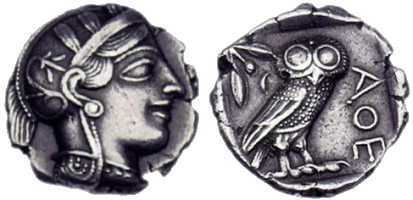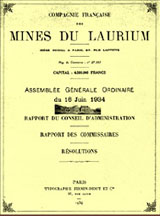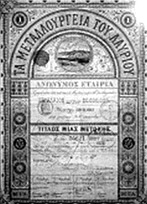Lavrion and Antiquity
Lavrio is the one of the two towns of Lavreotiki, a municipality on the southeastern side of the Attika prefecture. Its name comes from “lavra” or “lavri”, which means narrow passage, tunnel. In fact, all the area is full of ancient and modern mining galleries.
Lavrio, in spite of its small scale (about 10.000 habitants) has been one of the most important industrial centers in Greece during 19th century. It was built as a worker's settlement, in the newly founded Hellenic State, partly following the "company model". The formation of Lavrio, through emigration, had been inherent to the exploitation of its rich subsoil that was, in its turn, directly linked to the effort of the new State to develop its resources and industry in the 19th century.

The ancient Greeks started mining in the area before 3000 BC. The systematic and intensive exploitation of the silver and lead ores though, began with the birth of the Athenian Republic in 508 BC. The immortal monuments of the Golden Age of Pericles have been realized by means of the silver of Lavrio, together with the tax contributions of Athens’ allies. After the end of classical antiquity, any important mining and metallurgical activity have been ceased in Lavreotiki. Many centuries of relevant inactivity have been followed.
Mining at Lavrio in the 19th and the 20th Century
In 1863, the Italian mining engineer and operator J.B.Serpieri, gets convinced to exploit the ancient slags, after having been consulted the detailed report of the young mining engineer A. Kordellas, who was sent by the Greek young government to visit Lavreotiki in1860, on that purpose. In 1864, Serpieri founds the Italian - French company "Hilarion Roux et Cie" at the "Ergastiriakia port" (port of Lavrio). The company undertakes the exploitation of the ancient slugs and the extraction of silver containing lead ores. It inaugurats a fully equipped plant in 1865, with 18 furnaces, small ore-washing units and a railway system. The company continues to expand fast. In 1867 already, it employed 1.200 workers, a record number compared to contemporary employment figures country-wide.


In 1869, there is a dispute between the company and the Hellenic State,the renowned "Lavreotika Affair", over the ownership of the ancient mining dumps, known as off-grade ores. Negotiations result in the setting up of two companies in 1873: "The Lavrion Metallurgical Company" and the French-Hellenic company named "Mines of Kamariza". Two years later, in 1875, J.B Serpieri founded the "Compagnie Francaise des Mines du Lavrium", which succeeded the "Mines du Kamariza". The new firm was settled at the Cyprianos area.
Both the Hellenic and French companies have been the essential supporting factors of Lavrio area's development in that new period of the industrialization of Greece. Furthermore, the two companies put their seal on the emersion of the mining industry in modern Greece as well as on the creation of a new town character. The 1867 workers' settlement was finally developed into a 10.000 inhabitants' town in the beginning of this century. The French Company, bigger of the two of the kind, built a total of 45.000 m2 of installations on Cyprianos site.
The two companies have been, for a long time, responsible for the town's operation. A great number of houses and shops were belonging to them. They constructed urban infrastructures, such as schools, churches, a small hospital and port facilities, in order to facilitate their operations and attract working population. The Hellenic Company is associated with the use, for the first time in Greece, of electricity, the telephone and other technological innovations. Those included the construction of the Attikos railway (1882-1885), thus connecting Lavrion to Athens.
The birth of industry in the area of Lavrio, has caused, on the other hand, a degradation of the environment as a result of the intense mining and metallurgical activity. The natural landscape and the lush forest vegetation have been rapidly deteriorated. The swamps and the coasts were covered with solid wastes; the forests were often burnt down by arson, while smog from the furnaces covered the wider area over many kilometers.
Social life in Lavrio, having been so depended from the industries of the area, naturally followed their course. The first serious crisis came about in the 1880's and 1890's when the price of lead went down. The 1st World War thought, stroke the decisive blow. In 1930, the Hellenic company sold out its installations.
Towards the end of the 1920s, the population of the Municipality of Lavreotiki, was reduced by 50%. Refugees from Asia Minor in 1922 and, since, regenerated the city's population. In the mid 1950's, the town was introduced in a new period that lasted for several decades and was characterized by the development of new industrial branches: Electric power production, textile industry, army industry, appliances fabrication, etc.
During the late1980's and early 1990's, Lavrio faced a new cycle of crisis, as a result of the broader de-industrialization all over Greece. Tens of units ceased their operation and more than the 20% of the population left the town, due to unemployment.

The French Mining Company of Lavrion
1st period 1875-1904
In those years, the company constructs the core of its installations. Until 1895, the organized unit includes administrative buildings, mechanical processing installations and hydro- mechanical ore beneficiation, furnaces of thermal ore beneficiation and reducing of lead. The ores extracted from the mines are first beneficiated on the spot. The lead, zinc and mixed sulphide ones, undergo mechanical preparation by the dollies and the ore washing units at Kyprianos. Then the ores are metallurgically processed. There are two distinct procedures; the calamine calcination and the roasting and reducing smelting of lead sulphine. The final product contains 95% lead and is extracted as lead containing silver in sows.
2nd period 1905-1929
In 1905, a large-scale operation inaugurates the modernization of lead metallurgy. Two different new methods of the calcination procedure, according to the type of ore, are applied and the old furnaces are abandoned. Lead sulphides, containing large quantities of ferric disulphide, undergo full roasting from now on, by the Kauffmann method, while the rest which contain less ferric disulphide, are reduced by the Huntington – Heberlein method. Two types of Brunton furnaces are built and the bricketing unit is settled. From 1905 onwards, the factory is reorganized due to the installation of steam-powered electricity generating units, by the use of gas produced abreast. In 1913, the company attends to expand its metallurgical activities by further processing the reducing smelting products.
3rd period 1930-1989
In the late 1920’s, the company faces problems when prizes of lead continue to fall and cost effective ores are gradually depleted. It attempts to deal with the crisis by modernizing the beneficiation method and by producing pure lead for the home market. From 1930 onwards, the “flotation” method is being applied. For the production of pure lead, the extraction of silver by using zinc is used, while after 1936, sheets of lead are produced at a rolling mill. In 1930, due to the depletion of ores, the operation of the calamine calcination furnaces is not profitable anymore and it stops. The company is bought by the multinational “PENARROYA”. The last important innovation carried out at the complex, is the installation of a building-scaled smoke filter, in the early 1950's.
Some of the buildings still preserved nowadays, were built in 1875-76 and continued to house stages of the productive process until 1988. The complex ceased its operation permanently in 1989.
Soon after the closure, the ambitious project of the National Technical University of Athens, was initiated in order to convert the former metallurgical site into a Technological Cultural Park and Museum of Technology.
You can see more photos here
The crisis and the birth of the Technology Park
The industrial crisis
During the decades of the '70s and '80s, a crisis hit the most important industrial centers in Greece, including Lavrio, one of the most innovative territories of the national industrial activity, during the 19th and partly the 20th centuries. In 1977 the «French Mining Company of Lavrion» (FMCL), having run for more than 100 years in the region, ceased mining activities and was introduced at a time of crisis. Seven years later, after a series of internal turmoil and unsuccessful efforts to get reorganized, the company ceased its metallurgical activities. Chain reaction has been spilled over into all major industrial plants of the region, which started interrupting their production lines, either transferring them to other areas with positive outlook, or ceasing them definately. The town of Lavrio faced fierce unemployment problem that caused social disintegration in the region.
Reuse Proposals
Following to a preposal of some professors of the N.T.U.A. (Schools of Mining and Metallurgical Engineering and School of Architecrure) the Senate of the Institution initiates to the Government the rescue of the installations of the old FMCL introducing the concept of a “technology park” and a “museum of mining & metallurgy”.
During the 1980's, already before the definite closure of the factory, an open and long-lasting discussion concerning the various re-use prospects of the FMCL complex and infrastructures, took place. Town authorities, company executives and academics in the field of mining and metallurgical engineering participated in those broad discussions in which the historical value of the area and the plant complex was widely acknowledged, and the need to preserve their historical, architectural and technological characteristics was emphatically stressed.
In those discussions two options were identified: (a) The first one called for a restoration and re-use of the plant complex and its surrounding site for various social and cultural purposes, e.g. theatres, museums, exhibition centres, recreation facilities, educational training, sports and leisure activities, etc. One of the most characteristic exemplars of such an option in the region of Attica is the old Gas Factory of Athens that was restored and re-used as a municipal cultural centre. (b) The second option was more sensitive to the historical account of technology imprinted on the plant and its site during its successive rounds of operation since the mid 18th century. This option stressed the importance of preserving the technological-historical identity of the complex through an innovative initiative aiming at the renovation of the old plant complex and its re-use as a technology and cultural park. At a symbolic level, the park would revive the area’s historical identity and collective memory as a place of production since the ancient times. At a more pragmatic level, the park would contribute to the technological upgrading of Athenian manufacturing industries by means of technology transfer, spin-offs, new business environment creation, advanced infrastructure and development of new applications and process or product innovations. Thus, the idea of the Lavrion Technology and Cultural Park (LTCP) was born. After being sold to the Greek Public and given to the Ministry of Culture, due to its nature, the site is being assigned to the N. T.U.A. (12.30.1992). A funding program is elaborated and submitted to the District of Attica, within the scope of the 2nd Community of Support, which is approved in March 1994, first for a sum of 3,6 billion drachmas. The 25% of the national contribution is being covered by the Ministry of Development after the personal interference of the Prime-Minister himself. Until 1996 the Park has being managed by a special Senate Comity and since then by the consisted Association for the Development and the Management of the Property of the N.T.U.A.
The Lavrion Technological and Cultural Park (LTCP)
 The National Technical University of Athens (NTUA) undertook the venture with much enthusiasm. By building upon local popular support and internal scientific initiative, the NTUA responded positively to the challenge at issue and elaborated a new model of technology-based regional socio-economic and cultural development, which was in accord with the needs created by the emerging global “knowledge economy” in which Greece and the Region of Attica are striving to find their place. This model reflected the NTUA’s specific character: As a technical university, the NTUA does neither observe nor conceive technology the way it is done by the market. A technical university, in general, perceives technology more as a particular way of thinking that brings together human skills, insight and productive imagination, than as a mere commercially exploitable input to the production processes.
The National Technical University of Athens (NTUA) undertook the venture with much enthusiasm. By building upon local popular support and internal scientific initiative, the NTUA responded positively to the challenge at issue and elaborated a new model of technology-based regional socio-economic and cultural development, which was in accord with the needs created by the emerging global “knowledge economy” in which Greece and the Region of Attica are striving to find their place. This model reflected the NTUA’s specific character: As a technical university, the NTUA does neither observe nor conceive technology the way it is done by the market. A technical university, in general, perceives technology more as a particular way of thinking that brings together human skills, insight and productive imagination, than as a mere commercially exploitable input to the production processes.
Under such a perception, the LTCP was not conceived simply or merely as a “profit-making” pole of regional macroeconomic growth, but rather as a socially constructed means of enhancing and improving the region’s human, intellectual and cultural “capital” that consist the cornerstones of the new economy. In other words, it was perceived as a means of transforming a hidden but exploitable system of possibilities into a practical model of self-sustained developmental process, oriented towards the future. In that context, the vital difference between LTCP and any other typical Greek science and technology park lies on the fact that the LTCP tenant companies view their prospects as organic part of an integrated socio-technological, business and cultural environment; an environment that consists not only of technology transfer, interactive technological learning, business competition and profit-maximization behaviour, but, also, of the social and cultural values and norms that are inextricably bound to the emerging new knowledge-based economy.
By the summer of 1995 the administrative actions for the establishment of the park and the studies for the restoration of the plant complex had been completed. The relevant funding derived from both EU and national sources of funding raised at about 5.19 billion drachmas (15,23 million Euros). The program concerned the restoration –upgrade of 17 from the total of 42 buildings, built in the period 1876-1898, the construction of two new buildings, the tidying up of the environing space, so as the rehabilitation of a heavy polluted part of the grounds (10,000s.q.).
